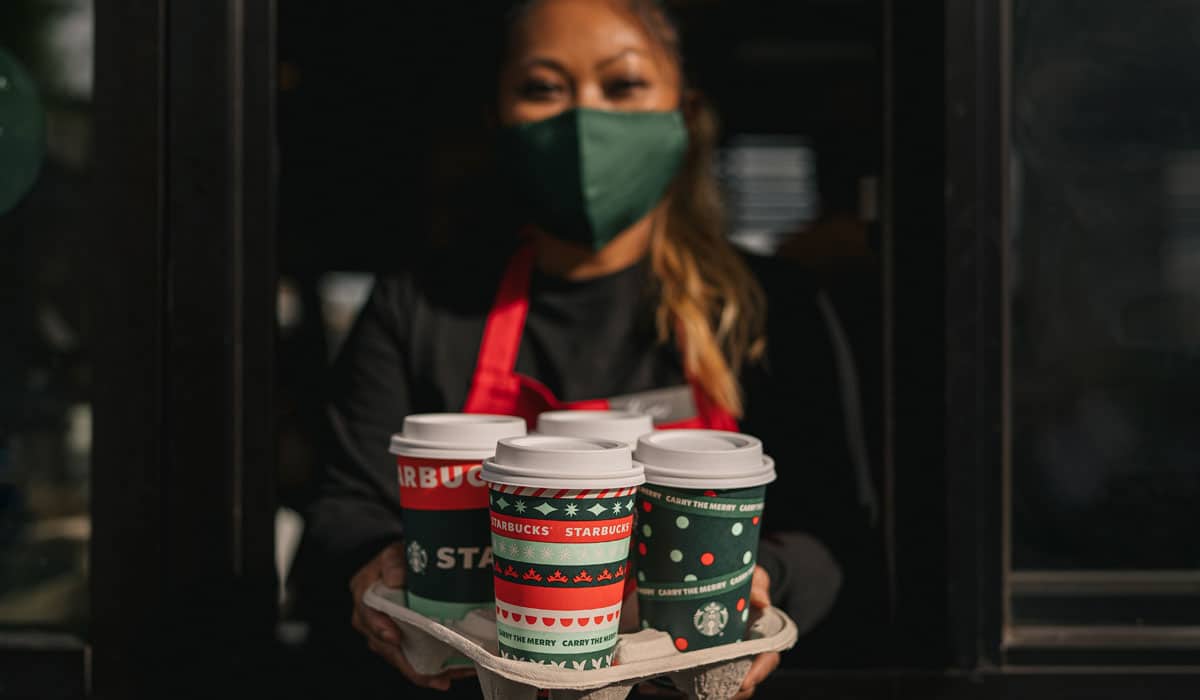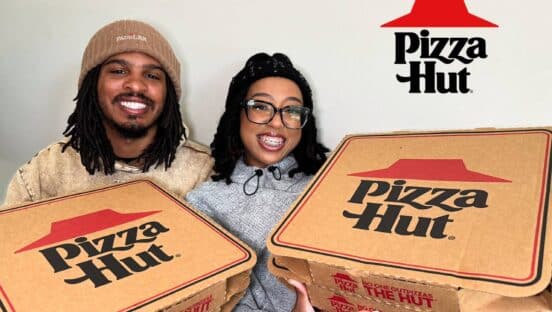The days of Starbucks digging in and playing defense are over, CEO Kevin Johnson said Thursday during the company’s quarterly review. For all the turbulence of recent weeks and months, from inflation to labor shakeups, one trend line has been easy to connect: When restrictions drop, customers return. “So, this is an opportunity for us to move now,” Johnson said. “We can’t wait.”
Starbucks is on the verge of investing $1 billion in incremental annual wages and benefits, something that will unfold in stages. By summer 2022, the company will offer a starting wage of at least $15 per hour for store-level workers, making good on a promise from December 2020. Come January, employees with two or more years tenure will receive up to a 5 percent raise and those with five or more years will see wages lift 10 percent. In all, Starbucks said hourly U.S. employees are set to make an average of nearly $17 an hour with baristas taking in $15–$23.
It’s no secret COVID reset the workforce dynamic. The industry remains roughly a million jobs short of 2019 marks, and quick-service turnover rates are pushing 170 percent, per Black Box Intelligence. In August, 4.3 million people across America quit their jobs as instances increased month-over-month in 14 states. Overall, the nationwide quit rate of 2.9 percent was the highest percentage ever reported by the Bureau of Labor Statistics Job Openings and Labor Turnover Survey series. Specific to hospitality, 58 percent of employees, in a survey conducted by Joblist, said they planned to quit before the end of 2021.
Starbucks countered aggressively out of the gates. It gave employees economic certainty and avoided layoffs, furloughs, and decided to pay workers despite stores closing nationwide. “And so why do you think we drove a faster recovery than people expected? Why did we drive a faster recovery than others in the industry?” Johnson said.
Still, over the past 12 months, 70 percent of Starbucks’ hourly employees were new to the brand.
It’s why part of the chain’s wage investment includes a redesign of its “Barista Basics” guide. The company layered in training for every role and practice shift and plans to expand its 40 “training stores.” In addition, Starbucks will test a “shifts app” that offers flexibility—one of the biggest incentives requested today as people grapple with childcare, school, and seek out a bridge back into the workforce.
Starbucks hired recruiting specialists in U.S. markets and expanded a $200 referral bonus program as well.
Johnson said Starbucks is taking steps to drive automation into stores in an effort to make employees’ lives easier and more consumer-centric. One major change being automated ordering for food and merchandise through Starbucks’ Deep Brew AI program, which he noted would roll across all domestic corporate stores by the middle of Q1 2022. The system will take inventory management off the daily task list of in-store employees.
How Starbucks looks at the broad runway, however, and why $1 billion is a check it’s willing to write, is a twofold point, Johnson said. One is the fact Starbucks is “on the front foot now” and has the opportunity to accelerate by investing in its growth curve. The other, Johnson believes, is the idea it’s time to chase market share gains at this fork of the COVID recovery, which, unlike most pandemic narratives, is not a transitory reaction. “This is the time to take that market share that we know we can take and that market share gain is permanent,” Johnson said. “That market share gain will build long-term customer engagement, long-term customer loyalty, and that market share gain will also drive operating leverage in our stores.” And it starts with staffed restaurants.
Accentuating the “front foot” statement, Starbucks’ U.S. same-store sales increased 22 percent in Q4, announced Thursday, driven by a 19 percent jump in comparable transactions and a 3 percent year-over-year lift in average ticket. The company’s two-year comp was up 11 percent and it only gained in September, up to 14 percent.
Starbucks’ Q4 global revenue reached $8.1 billion—22 percent higher than last year. The quarterly record closed out a fiscal-year best $29.1 billion.
Alongside employee investments, Starbucks also made the 2020 call to reposition 500 stores. That meant more drive-thrus, new store formats designed for digital, and a push to suburban markets. CFO Rachel Ruggeri said Starbucks expects to add 2,000 net new locations in 2022, a significant rise from the 1,173 this past year. She said the brand “successfully completed closures” in its North America trade area transformation program and is now refocusing on growth. About 75 percent of that 2,000 aim will take shape outside the U.S., giving Starbucks global net new store expansion of 6 percent.
COO John Culver added guest behaviors and routines are starting to normalize, too. Peak hours have returned to pre-COVID times. The morning daypart is coming back. Cold beverages accounted for 75 percent of Starbucks’ beverage sales in Q4. Food was up 35 percent, espresso 34 percent, and larger tickets continue to reflect the brand’s efforts to funnel guests into digital channels. Currently, drive-thru and mobile order and pay account for 70 percent of Starbucks’ transactions, which is 15 percent above prior levels.
Starbucks grew its 90-day active rewards base by 30 percent this past year to 24.8 million members. They accounted for 51 percent of U.S. tender in corporate stores in Q4.
Going back, one of the key unlocks for Starbucks’ loyalty base was to expand payment options (guests used to have to load funds onto a card). Today, they can use PayPal, personal cards, and even Bakkt, where a customer reloads their Starbucks card with a range of cryptocurrencies, including Bitcoin and Ethereum.
Johnson said the brand is now exploring, through blockchain or “other innovative technologies,” the ability to “tokenize Stars.” Dressed down, this will enable other merchants to connect their rewards program to Starbucks’ platform. Guests could then exchange value across brands and swap loyalty points for Stars at Starbucks. The brand is trying this with Air Canada.
Over the next year, Johnson said, expect to see Starbucks launch this loyalty points exchange with other consumer brands for the first time in the U.S. The approach, he added, will serve “as a foundation for a more aspirational concept for new, modern payment rails that align payment expenses with the value received by customers and merchants.”
“We intend to be at the forefront of this disruptive innovation, which will unfold over the next few years,” he said.
More near-term, Starbucks expects a “record-breaking” holiday run. Johnson estimated nearly $3 billion will get loaded onto Starbucks Cards this season, and the chain will create a promotional presence in drive-thru lanes to reflect pattern shifts. “We are ready for this holiday,” he said.
Starbucks hasn’t side-stepped labor and inflationary challenges. The brand has had to adjust staffing levels and operating hours at times to navigate setbacks. This includes pulling back from the evening daypart and redeploying staffing into adjacent stores when needed.
While Starbucks doesn’t break out price, Ruggeri said there was about 200 basis points of margin dilution in Q4 related to “a combination of supply chain pressures, inflation related to the supply chain pressures as well that happened over government subsidies from prior-year investments.”
Supply chain challenges today are evident by inventory levels in certain units. Culver said impacts began in mid-fiscal 2021 and will likely continue into 2022. Starbucks saw headwinds on commodity pricing challenges around transportation and the ability for distributors and manufacturers to find labor to work in factories and distribution centers, Culver said.
In response, Starbucks added new manufacturing and supply partners across critical categories, like oat milk and breakfast sandwiches. It’s also building throughput and production capacity. Suppliers are tacking on new lines. And Starbucks is working with them to “invest in wage for their workers and many of them have done so.”
“And the last thing I would say that what we’ve done is we’ve really focused our production efforts on high-volume items and some of those lower-volume items we pulled back on and deprioritized,” Culver said.
Throughout Thursday’s call, Johnson outlined a commitment to return $20 billion to shareholders over the next three years. “We see in every market around the world that as the spread of COVID gets under control market by market, customers return to our stores immediately,” Johnson said. “That’s why this investment in wage and ensuring we staff our stores with the very best and most talented Green Apron partners we can is so important. This is the right time to make that investment.’







